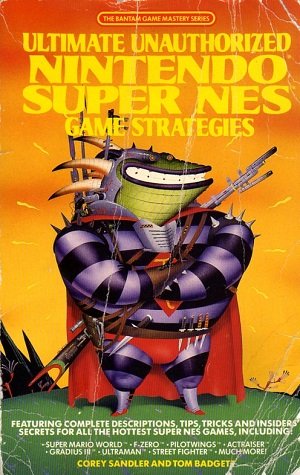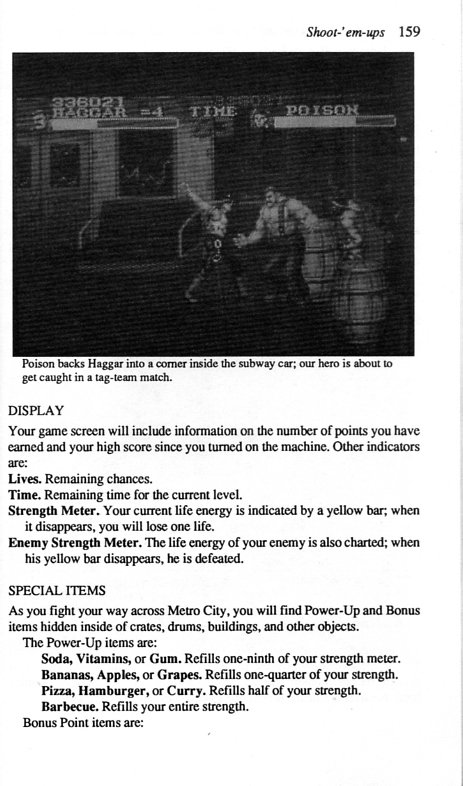
Note: Unless otherwise indicated, all images are scanned from my own source materials.
You knew it had to be coming.
Corey Sandler and Tom Badgett hit upon a winning combination for Bantam's "Game Mastery Series" with Ultimate Unauthorized Nintendo Game Strategies in 1989. The book sold quite well--so well, in fact, that they pair followed it up with two additional volumes on the NES, and a third devoted to the Game Boy, in 1990. Pushing out three complete books in one year wasn't enough for these guys though, so when 1991 dawned they continued the momentum by publishing Ultimate Unauthorized Nintendo Super NES Game Strategies. Your $9.95 US or $12.95 Canadian (what did our northerly neighbors do to deserve this price hike?) got you 220 pages of content this time around. I'd accuse Sandler of skimping on the page count this time around, considering the original clocked in at over 300 pages, but if the question is quality over quantity, maybe fewer pages translates to coverage of better games?
Let's have a look and determine for ourselves.
To Guide or Not to Guide?
So, how many games can one smash into 220 pages? Would you believe twenty-eight?
I know, it doesn't seem like much. The first book contained write-ups on more games than that just in its first section alone. But look at the date this book was published and you'll have to change your tune. Twenty-eight games is actually a lot of software, considering the Super NES launched in the US in 1991 with only five games. But hey, five games is better than the whole two the Japanese market got to play upon their launch systems. So just where on earth did Corey Sandler and his son Willie, who served as the primary playtester so dad could write (Jeff Rovin wasn't the only one who pressed his progeny into helping him meet a deadline) get their hands on nearly thirty pieces of software, most of which weren't available in the US market at the time of the book's writing?
Enter Dave Halverson.
If you aren't familiar with the name, you're likely familiar with the work he's done. Halverson was founder and editor in chief for a number of video game periodicals. Most recognizably Diehard GameFan and Play fell under his editorialship. But there would have been no Diehard GameFan magazine without "Die Hard", a small-business video game shop based in Tarzana, California that specialized in import titles. Sandler gives credit to Die Hard in the acknowledgements section for their help in securing Super Famicom hardware and software from overseas, so even though he isn't mentioned by name, without Halverson and his staff
Additionally, many of the game write-ups include a disclaimer that they're being produced from pre-release sources, Japanese editions of the game, and in one case last year's Sega Genesis edition of the upcoming software, so things are subject to change between now and press time. This is EGM-level territory Sandler invades, getting to see beta builds and in-house demonstrations of the software. Other book authors rarely had this level of access to software, so it's already awesome from a historical perspective.

For example, this Final Fight screenshot featuring Poison before her excision!
Other changes aren't as extreme. The oddest is the entry for Bombuzal, which was released here in North America as Ka-Blooey. You'll also notice changes in character and place names for a lot of the games where Sandler was working off the Japanese version ('Tigley Quarry' instead of 'Tigray Quarry' in Wanderers From Ys, for example), but these are more curiosities as opposed to localization errors. In fact, the only real mistakes I could find reading through the book with hindsight fully engaged is an upside-down image for Gradius III on page 43, and an incorrect ratings score of 1 on Actraiser that should have been 11. Whoops...
The back cover also claims the book covers Street Fighter, but that's a lie. I'm assuming they meant to put Final Fight on there and just screwed up, since no versions of Street Fighter had been announced for the SNES at that time.
Not to Guide (With Reservations)
In case you weren't able to tell from the cover scan, my copy of this book was read cover-to-cover, lugged around in a backpack, lent to friends, passed around the playground, jammed into tightly-packed desks, and ultimately came back to me far more well-loved and well-traveled than almost any other book in my video gaming library. I read the ever-loving shit out of this book, my friends read the ever-loving shit out of this book, and I'm pretty sure most of their siblings and friends read the ever-loving shit out of this book too. The cover's about 1/3rd of the way completely torn off at the bottom. It got around more than a hooker offering a 2-for-1 special on Friday night.
So why the 'Not to Guide' rating?
Because nostalgia's all well and good, but at the end of the day we have to consider what you got for the money. While there's a lot of talk of previews and upcoming software, there's very little in terms of the "Super NES Game Strategies" promised by the cover. Most of the game write-ups are devoted to explaining the game's setting and controls. There's the occasional tip or hint tossed in, but if you were buying this hoping for some killer passwords or cheat codes, you'll find this book quite barren. It was an awesome sneak preview of what was coming, and the screenshots look a darn sight better than they did in the first book from 1989, but ultimately it isn't all that useful.
Unless you consider yourself a gaming historian, and then it's worth its weight in gold, for the aforementioned reasons. Seeing Poison in a Final Fight prototype SNES cart is awesome. The fact "Die Hard" was involved (albeit indirectly) with the book's production is great trivia. The Japanese screengrabs for games like Wanderers From Ys are fun to look at (especially the one where Dogi yells, "あぶない!!" ("Danger!!") to get Adol's attention). Sandler's text and Badgett's layouts are based in a bygone era, from a time mere months after the Super Nintendo launched in North America, and information was scarce. Comparing Sandler's reporting with the eventual end results is great fun, just like reading through old magazines and realizing something changed between the preview and the final version.
If you aren't interested in that stuff, then give this one a pass. You'll get far more mileage out of something like the full-color Super Nintendo guide published by Nintendo Power. This isn't worth the current asking price of around $8.00 unless you're looking to go down that research rabbit hole or are just collecting these things for the hell of it.
It may have only been 5 games but what a quintet to start with.
Downvoting a post can decrease pending rewards and make it less visible. Common reasons:
Submit
No kidding! Super Mario World, F-Zero, Pilotwings, SimCity, and Gradius III. Five titles carefully curated to punch Sega's marketing machine right in the face by showing off all the stuff the Genesis couldn't do. It was beautiful. :)
Downvoting a post can decrease pending rewards and make it less visible. Common reasons:
Submit
Hello🌹
Downvoting a post can decrease pending rewards and make it less visible. Common reasons:
Submit
Good evening, @sakurasui! How are you today? :D
Downvoting a post can decrease pending rewards and make it less visible. Common reasons:
Submit
I'm at my top gear now!! And I've already gone insane! This means I'm alive and well. thank you. I hope you are also doing well🌹
Downvoting a post can decrease pending rewards and make it less visible. Common reasons:
Submit